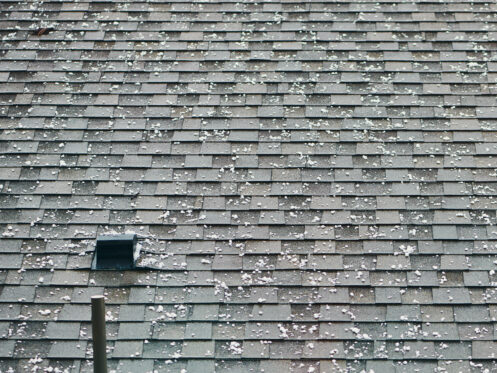Peak thunderstorm season in Atlanta, GA runs from March through May, but the potential for wind and hail damage lingers throughout the fall and winter seasons. While heavy, hard-hitting hail is an infrequent weather phenomenon in the region, hailstorms have become increasingly common in recent years. This makes it important to know the signs of roof hail damage. The following are 10 ways to know if your roofing has been compromised.
1. Your Roof Has Been Hit by Hail With a One-Inch Diameter or Greater
The most important thing to know about hail damage is that it isn’t always easy to see. Even if your roof looks normal when viewed from a ladder or the curb, large, heavy hail is cause for concern. If recent hail had a one-inch diameter or greater, have a professional assess your roof to find hidden or developing issues.
2. Dented and Detached Gutters and Downspouts
During major hailstorms, gutters and downspouts can take a beating. Check these features for large dents and gouges and for sections that have pulled away from the building. If your gutters are loose or misshapen, there’s a good chance that hail has damaged your soffits and fascia, too.
If you can’t see any gutter damage when viewing these features from your yard, check other metal structures on your property. If hail can dent “soft metal” mailboxes, garage doors, and sheds, it’s heavy and impactful enough to damage rooftop drainage systems as well.
3. Missing Shingle Granules
Missing shingle granules are a common sign of age-related wear. Shingle granules protect roofs from UV damage while directing runoff toward gutters. Losing them often means that shingles have lost much of their oil-based moisture and flexibility. However, being battered by abrasive, fast-moving hail can also cause granule loss.
Residential roofs are many-layer systems. Each layer works with all the others to form a durable, watertight seal. Given that shingle granules are the very first layer in this system, their loss can lead to progressive roof damage if left unchecked.
Your shingles may have lost their granules if your roof has many small, dark-colored patches when viewed from the curb. These may be areas where falling hail removed shingles entirely or caused pitting. You can also check for shingle granules in your gutters and at the base of your downspouts.
4. Dented, Bent, or Broken Shingles
Among the most common signs of roof damage are dented, bent, or broken shingles. A great way to streamline the claims process for hail damage is by snapping photos of your roof while it’s still in good condition. When binding a new home insurance policy and at regular intervals throughout your policy’s term, taking photos of your roof documents its “before” condition. Not only can you share these images to prove the damage that hail has wrought, but you can also use them to spot structural and aesthetic changes when conducting your own post-storm inspections.
5. Missing Shingles
When hail makes an appearance in Georgia, it usually comes with forceful, fast-moving winds. Being battered by frozen precipitation and pushed by strong wind forces may cause shingles to detach. Depending upon how strong wind forces are, you might find detached shingles in your yard or neighbor’s yard, or you may never see them again. You should always have missing shingles replaced right away to protect your roof’s decking, underlayment, and framing.
6. Dented or Punctured Flashing
Roof flashing is a thin layer of metal that adds extra leak prevention to vulnerable roofing elements like protrusions and roof valleys. You’ll find flashing everywhere two sections of roofing meet and at all exhaust vents, skylights, and chimneys.
Dented and punctured flashing are among the most common and easy-to-spot signs of hail damage. Wherever heavy-hitting hail has misshapen flashing, the underlying features are no longer protected by a watertight seal. It’s always best to have damaged flashing repaired or tarped before the next major weather event arrives. This will protect everything in the interior of your home, including your ceilings, walls, and rough framing.
7. Battered Roof Vents
Your attic vents release heat and moisture from your home. Hailstorms and heavy winds can leave these features blocked by debris. They can also damage their water seals or diminish their structural integrity in other ways. If wind-tossed tree limbs or especially hard-hitting hail strikes these features, your attic vents may be compressed or crushed completely. It’s also important to note that attic vents might not be the only vent type that your roofing supports. When inspecting your attic vents, be sure to check all exhaust vent stacks for range hoods, dryers, bathrooms, and more. Look for dented or missing caps, crushed sections, and perforations.
8. Blistered Paint and Pooling Water Indoors
Impact-related damages that significantly reduce the integrity of roofs can lead to visible moisture damage in building interiors, and often much sooner than homeowners think. If you wake up the morning after a hailstorm and spot wet ceilings, pooling, water, or blistered and bubbling paint, this could be why. As frozen precipitation on your rooftop melts, even ultra-small points of ingress will allow moisture in.
9. Cracked Siding
Depending upon the wind’s direction, your siding may have sustained impact damages, too. Check your siding for dents, cracks, and blemished paint. If your siding looks worse for the wear, you’ll likely find similar damages on your gutters, soffits, fascia, and eaves.
10. Exposed or Fractured Fiberglass Matting
Just beneath their protective granules, asphalt shingles have a layer of fiberglass matting. While shingle granule loss might expose a small amount of this matting in hard-hit areas, seeing large streaks or stripes of fiberglass mat means that your shingles have reached the end of their service lives.
Why It’s Important to Schedule Hail Damage Inspections Right Away
Some hail damages are purely cosmetic, but others have an immediate impact on the integrity and functionality of roofs. Scheduling hail damage inspections immediately after storms minimizes the severity and costs of all related repairs. Timely inspections and repairs are all the more important when hail damage occurs at the very start of Atlanta’s thunderstorm season.
Many home insurance plans, roof warranties, and home warranties require homeowners to take fast action when suspecting hail damage. Having a licensed roofer document the problems that a recent storm has caused will simplify the claims process and reduce your likelihood of experiencing frustrating delays or denials.
Hail Sizes and Their Impact
Hail with a diameter of one inch or more can cause significant damage to siding, gutters, and roofs. Hail measuring two inches in diameter or larger can detach siding, gutters, downspouts, and shingles. It can additionally block or crush roof vents and completely penetrate softer roofing elements such as ridge caps. The impact that hail has on roofs, roof vents, and siding or other surrounding features is also determined in part by wind forces, the duration of hailstorms, and the angles of impact.
We proudly serve homeowners in Atlanta, GA and the surrounding cities. We offer expert roof repair and replacement services. We also provide gutter repairs, storm damage repairs, and emergency roofing services. To request a quote or schedule an appointment, contact Fraser Roofing, LLC now.

